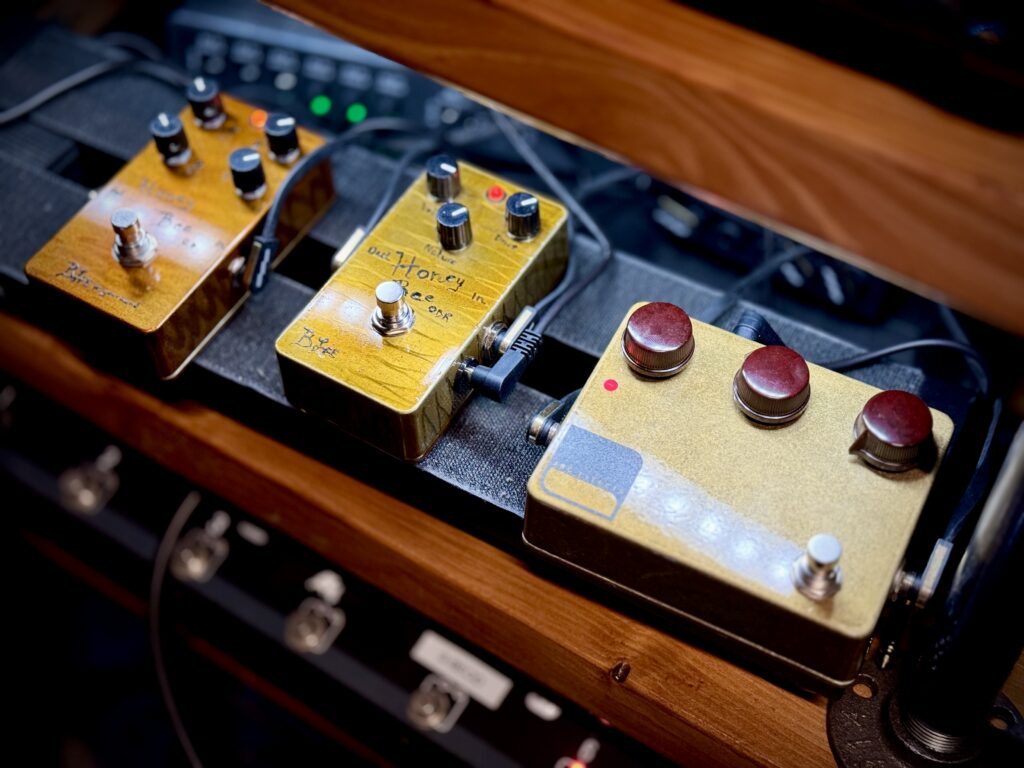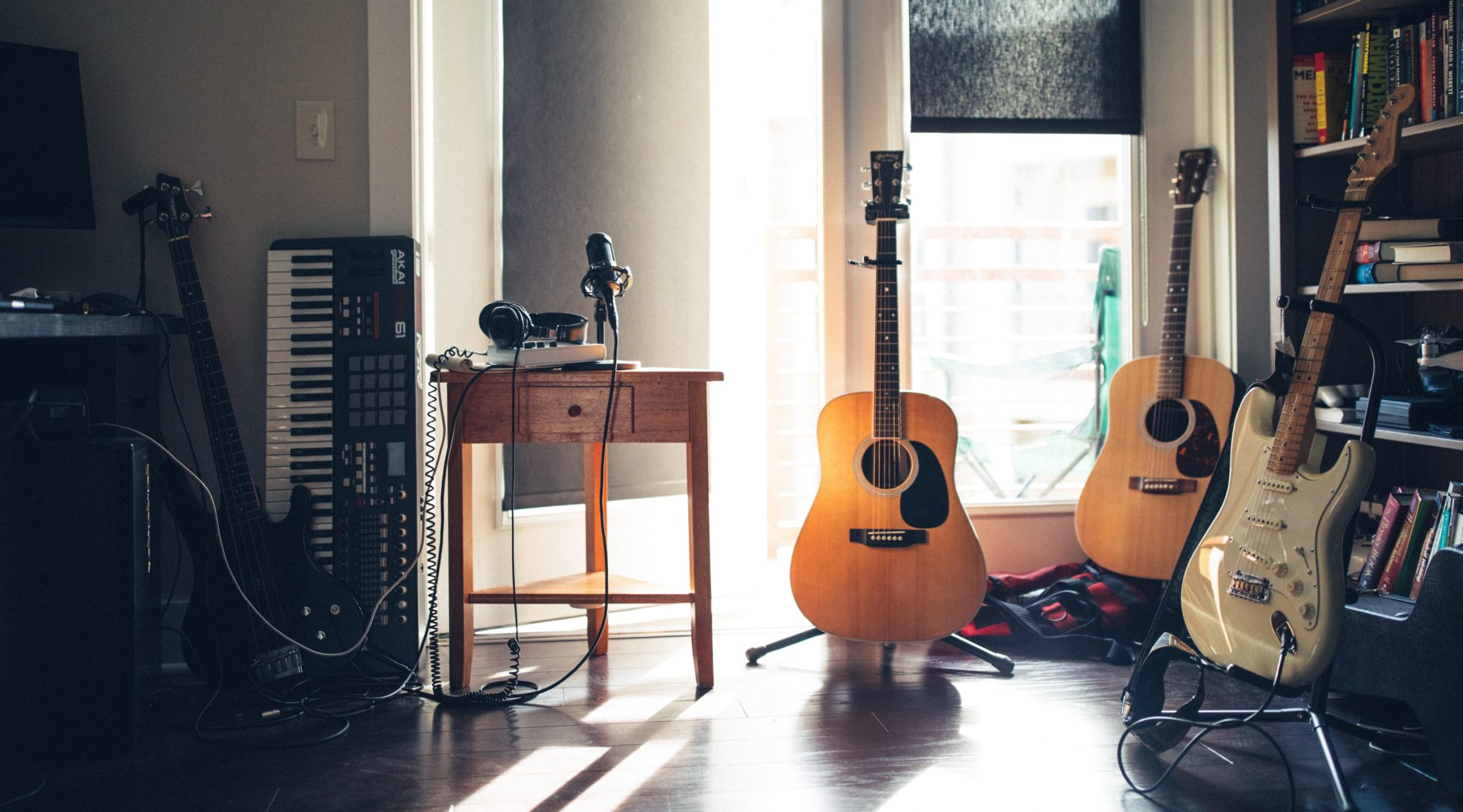Earlier this month, I picked up one of my holy grail pedals: a Honey Bee OD made by BJFe.

What do I think of it? Read on for my First Impressions.
What Did You Buy?
I bought a BJFe Honey Bee OD Retro overdrive pedal.
- “BJFe” is the manufacturer
- “Honey Bee” is the pedal name (and also the name of the family of related circuits)
- “OD” is for “overdrive”
- “Retro” is the pedal variant
It is also known as:
- Honey Bee ODR
- HBODR-3K
I bought mine from the UK second-hand market.
What Is It?
The Honey Bee ODR recreates the sound and feel of the original (much sought after, early serial number) Honey Bee OD pedals. I believe it’s a reissue of the original circuit, but I haven’t seen that explicitly stated anywhere.
Why Did You Buy It?
I Wanted An Original BJFe Honey Bee
I’m a big fan of the Honey Bee family of overdrive pedals for several reasons:
- it’s an absolutely legendary boutique overdrive pedal, that belongs in the same conversation as other legends like the Analogman King of Tone and original Klon;
- it’s one of (if not the) longest-running series of tweed-tone pedals;
- it’s the cousin of my beloved Mad Professor Sweet Honey Overdrive (SHOD for short) – which was also designed by Björn Juhl
I’ve played quite a few Honey Bee ODs over the years, but they’ve always been either from Bearfoot FX or One Control. I’ve never played one made by Björn himself.
And until the Retro model came along, I thought I never would.
Why I Went With The HBODR-3K
I wanted this pedal for the same reason that I bought my Fender Tweed Deluxe amp: I wanted something that gets as close to the original as possible (warts and all), so that I can learn more.
For the Honey Bee OD, “as original as possible” means a BJFe Honey Bee OD with an early serial number. How early? Before serial number #147. That’s when the circuit really started to evolve.
Arguably, the changes that have come since (re-voicing, extra gain, extra output level) are improvements (just like most modern Tweed Deluxe amps aim to fix the flaws of that original 5e3 circuit). I just find that it’s a lot easier to understand (appreciate? document?) the later circuit revisions if I’ve got some experience with the original.
Unfortunately (for me), these early serial number HBODs are very sought after, and command very high prices on the second-hand market. Those high prices have put me off, especially as I’d have to pay import charges on top to bring one to the UK.
Then I came across the Honey Bee OD Retro.
It scratches all the itches:
- an original BJFe-made pedal,
- that sounds like those early serial number HBODs
- but without the price tag to match.
I was about to order a brand new one from PrimoFX in the USA (especially as the dollar is low right now) when – as luck would have it – a Honey Bee OD Retro turned up on the UK second-hand market.
But Didn’t You Just Get Another BJFe Reissue Honey Bee OD?
That’s true: I recently bought a BJFe-in-your-hand Honey Bee OD 4K from One Control of Japan. It’s a pedal that’s (according to HBOD owners) also nails the sound of those early serial number Honey Bee OD pedals.
You wouldn’t be alone in thinking that one of them is going to be a redundant purchase.
Turns out, that’s not the case at all. I’ll cover that properly in a dedicated side-by-side blog post very soon.
My Rig Today
Today, I’m playing:
- a couple of guitars
- into my Axe-FX 3 (mostly for the tuner)
- out to my pedalboard
- back into the Axe-FX 3 (for EQ, virtual amp, virtual cab, delay and reverb)
- out to my audio interface
- and into my DAW.
For guitars, I’m playing my Gibson Les Paul CR8 (aka GP) and my Fender 52 reissue Telecaster (aka Jessie). Jessie’s my #1 guitar for my Tweed Deluxe amp and for all things tweed-tone. GP brings a fatter guitar signal that’s going to help me show off part of what makes the early Honey Bee ODs different to over variants.
On the pedalboard, I have the Arc Effects Klone v2 and BJFE Honey Bee OD Retro in separate loops of my trusty Gigrig G2. The G2 allows me to take the Klone v2 completely out of the signal path when I’m not using it, so that it cannot colour the sound at all.
I’m using the Arc Effects Klone v2 partly because it sounds close-enough to my Klon KTR, and partly because it’s living on my board until I find a box to pop it in 😁
The Axe-FX 3 is running my 57 Vintage pedal platform preset. Partway through, I’ll switch over to using my Tone King Imperial MKII Synergy preamp module into my HTB Synergy Imp preset.
All the delay and reverb in the audio demos is coming from the Axe-FX 3. There’s no post-processing applied in my DAW. I will have level-matched the audio before publishing.
How Does It Sound?
What Settings Am I Using On The Honey Bee?
I’m running the Honey Bee OD-Retro 3K with these settings:
- Gain around 2 o’clock
- Nature around 2 o’clock
- Volume around 3 o’clock
I’ll mention any changes to the settings as I go.
It’s A Very Low-Volume Pedal
Plugging the pedal in to test it, I was immediately struck by just how quiet this pedal is. I had to turn the volume control up past 2 o’clock to hit unity volume on the output.
Cranking the output so much doesn’t seem to introduce any noise problems, even with single coil pickups. (Not a surprise; I first fell in love with Bjorn’s designs because of their low noise floors, something which wasn’t that common with pedals back then.)
So … perhaps not the right member of the Honey Bee family if you want to slam the front of your amp? Absolutely not a problem for someone like me, who plays into clean amps.
(I have read that some Honey Bee OD Retros do have a higher output than this. Bjorn is well-known for customising circuits on request for his customers and his dealers alike.)
It’s A Very Low-Gain Pedal
Hand-in-hand with the low output, this pedal also doesn’t overdrive very much either. It’s got the lowest gain of any Honey Bee that I’ve recently played, even less than the Honey Bee OD 4K Mini Standard I reckon.
Here’s Jessie into the HBODR-3K.
To my ears, that’s a very low-gain tone. There’s a hint of dirt on it, especially when I dig in. Even for me, there isn’t enough overdrive there for me to use it as a rhythm tone.
But wow – I think the overall tone itself is 🤤 That’s one of the best Telecaster tones I’ve never managed to dial in.
It Can Be Quite A Dark Pedal
Switching over to GP (my Les Paul), the tone changes substantially. I’m firmly a middle-position player, because that’s where I find the magic in my Les Paul, so let’s hear that first:
I haven’t touched any settings on the pedal or amp. It’s the exact same signal chain that I used for the first audio demo with Jessie. All I’ve done is swapped guitar. But the result is so different!
I don’t recall any of the other Honey Bee variants sounding quite this dark with my Les Paul. It’s dark to the point of sounding muffled, like there’s a blanket over it.
Note that I haven’t touched the Nature control on the Honey Bee at all. That’s partly because it sounds so good with my Telecaster that I don’t want to touch it, and partly because I’d rather manipulate the rest of the signal chain to get my Les Paul sounding how I want.
It Can Also Be A Bit Harsh
If I switch over to GP’s bridge pickup – and leave everything else the same! – I get this:
While I was recording the demo, I was really struggling with how much the top-end was coming through. I was hearing every little dink against the strings, every little plink when I fretted, and I thought it sounded pretty harsh to my ears.
Listening back, I don’t hear much of those things to be honest – especially with fresh ears. Mostly, it’s a little too full in the low-end, something that’s easily fixed with one of my regular EQ toys.
Still, to me, the tone lacks a certain sweetness that I’m used to from this family of pedals. Let’s see what I can do about it.
Exploring A Sweeter Tone Through A Different Signal Chain
Switching Amps And Cabs Makes A Huge Difference
I’ve swapped out my 57 Vintage preset for my Tone King Imperial MKII Synergy Preamp module, and I’ve swapped my virtual cabs over to Celestion V30s. This amp + cab combo replicates more contemporary pedal-friendly clean channels on modern amps (something that wasn’t a thing when Bjorn created the original Honey Bee pedals).
I’m back in the middle pickup position of my Les Paul. Everything else has stayed the same. Here’s how that sounds:
To my ears, that’s a noticeable improvement over my earlier audio demo. It conveys that humbucker fatness, while starting to bring back that note definition and top-end that was completely missing earlier.
Still, I want a bit more.
Boosting With A Klone For That Little Bit Extra
I’ve thrown on my Arc Effects Klone v2 to give me a little more note attack / definition and quite a bit more crunch. It’s running in front of the HBODR-3K with these settings:
- Gain around 8 o’clock
- Treble down below 11 o’clock
- Volume just above 10 o’clock
This is quite similar to a classic Klon clean boost setting. The main difference is where I’ve got the Treble control. Normally, I’d run that at around 1 o’clock. I think that makes the HBOD sound too harsh, so I’ve turned it down (as-if I’m boosting an amp, not a pedal).
Here’s how that sounds:
I absolutely love that raspiness that I’m now getting out of this Honey Bee. Despite going into a very non-tweedy signal chain, I think the HBODR-3K is sounding nice and tweed-like here.
Final Thoughts
I bought this pedal thinking that it’d just be a reference unit for me; something to use in side-by-side comparisons while I spent most of my time either with my beloved Mad Professor Sweet Honey Overdrive (SHOD for short) or with one of the other Honey Bee variants.
Once I figured out it how well it worked with the Imperial MKII setup, I haven’t wanted to play anything else. Instead of fiddling with gear, I’ve spent the last two weeks just … playing guitar.
This pedal’s been perhaps my happiest surprise of 2025 so far!
When the time came, I found it a real struggle to take the Honey Bee OD Mini 4K Standard off the board so that I could try out the Honey Bee OD Retro. It’s going to even harder to make space for the next pedal that I need to write about.
And the next pedal has a lot to live up to.
